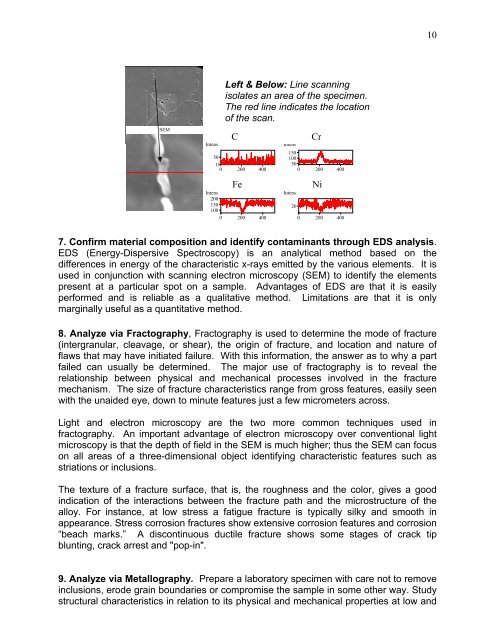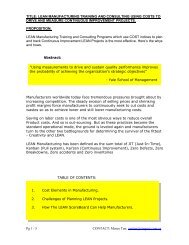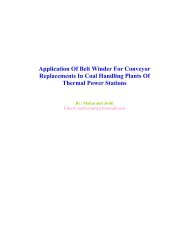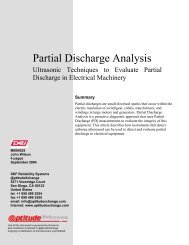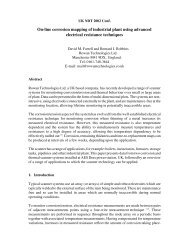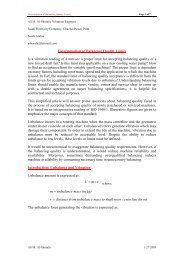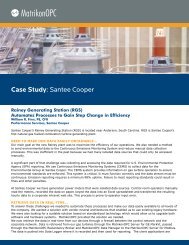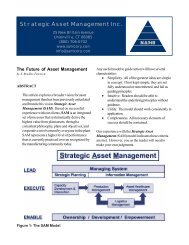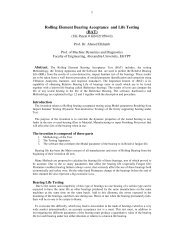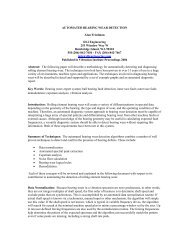A Re-Examination of Failure Analysis and Root Cause Determination
A Re-Examination of Failure Analysis and Root Cause Determination
A Re-Examination of Failure Analysis and Root Cause Determination
- No tags were found...
You also want an ePaper? Increase the reach of your titles
YUMPU automatically turns print PDFs into web optimized ePapers that Google loves.
10SEMIntensLeft & Below: Line scanningisolates an area <strong>of</strong> the specimen.The red line indicates the location<strong>of</strong> the scan.CC5000 200 400FeFeIntens2001501000 200 400IntensCr150100500 200 400Intens20CrNiNi0 200 4007. Confirm material composition <strong>and</strong> identify contaminants through EDS analysis.EDS (Energy-Dispersive Spectroscopy) is an analytical method based on thedifferences in energy <strong>of</strong> the characteristic x-rays emitted by the various elements. It isused in conjunction with scanning electron microscopy (SEM) to identify the elementspresent at a particular spot on a sample. Advantages <strong>of</strong> EDS are that it is easilyperformed <strong>and</strong> is reliable as a qualitative method. Limitations are that it is onlymarginally useful as a quantitative method.8. Analyze via Fractography, Fractography is used to determine the mode <strong>of</strong> fracture(intergranular, cleavage, or shear), the origin <strong>of</strong> fracture, <strong>and</strong> location <strong>and</strong> nature <strong>of</strong>flaws that may have initiated failure. With this information, the answer as to why a partfailed can usually be determined. The major use <strong>of</strong> fractography is to reveal therelationship between physical <strong>and</strong> mechanical processes involved in the fracturemechanism. The size <strong>of</strong> fracture characteristics range from gross features, easily seenwith the unaided eye, down to minute features just a few micrometers across.Light <strong>and</strong> electron microscopy are the two more common techniques used infractography. An important advantage <strong>of</strong> electron microscopy over conventional lightmicroscopy is that the depth <strong>of</strong> field in the SEM is much higher; thus the SEM can focuson all areas <strong>of</strong> a three-dimensional object identifying characteristic features such asstriations or inclusions.The texture <strong>of</strong> a fracture surface, that is, the roughness <strong>and</strong> the color, gives a goodindication <strong>of</strong> the interactions between the fracture path <strong>and</strong> the microstructure <strong>of</strong> thealloy. For instance, at low stress a fatigue fracture is typically silky <strong>and</strong> smooth inappearance. Stress corrosion fractures show extensive corrosion features <strong>and</strong> corrosion“beach marks.” A discontinuous ductile fracture shows some stages <strong>of</strong> crack tipblunting, crack arrest <strong>and</strong> "pop-in".9. Analyze via Metallography. Prepare a laboratory specimen with care not to removeinclusions, erode grain boundaries or compromise the sample in some other way. Studystructural characteristics in relation to its physical <strong>and</strong> mechanical properties at low <strong>and</strong>


